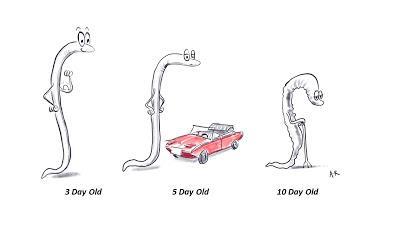
Life Span of a Worm by Arvind Ramanathan
So what exactly is this natural aging process? Many of us have been able to observe the entire arc of the process as we raised our family dogs. Do you remember something about how it went for Fido?At the age of two, Fido was a young, healthy adult, with tons of energy, good eyesight, keen senses of smell and hearing, and a shiny coat. He was able to learn and remember quite a few commands, like “sit,” “down,” “fetch,” and “off.” His mind was alert and attentive to you and his environment, and there was an obvious delight in new discoveries and exploration. But by the age of five, Fido was already entering middle age, and his energy and vitality were probably noticeably slower. Although he still loved to go on those long hikes with you, you may have noticed that he was bounding less and just focused on maintaining a steady pace. And when he jumped up onto the couch or bed, he wasn’t quite as spry. There were other changes, too, like maybe his digestion wasn’t what it once was or he started having trouble with bladder control. And with his immune system beginning to age, maybe your once super healthy dog started experiencing more illness or infections.By the age of eight to ten—depending on his size—Fido had become an old dog with a gray muzzle, heading into his final years. His energy and vitality were reduced even more, and though he still loved to go out and sniff things, those long hikes were a thing of the past. And he walked more slowly and stiffly, too, as his strength, flexibility, balance, and agility began to wane, and perhaps arthritis set in. His respiratory functioning diminished, so when he was very active, he became short of breath. And his keen hearing and eyesight also began to worsen (dogs even get cataracts, as do we). You might have needed to take Fido to the vet more often at this stage, as he developed more frequent infections or chronic illness, or any number of age-related conditions, such as heart problems, diabetes, digestive issues, obesity, or cancer. Perhaps even Fido’s mind wasn’t what it once was. He may have developed symptoms of cognitive dysfunction, such as confusion or disorientation, restlessness at night, loss of house training, decreased attentiveness, or not recognizing friends or family members.Eventually the really sad part came, when you had to say goodbye. Fido died while you were still young, probably of a fatal illness, such as cancer, an overwhelming infection, or just heart failure due to old age. Yes, we know, it was a bit difficult to witness, wasn’t it? After Nina’s family dog died, her mother said there would be no more family dogs because the thought of going through that whole thing again was just too painful. But remembering it now will help you understand quite a lot about how humans age, something we’ve been getting into a lot lately on the blog (Your Immune System and Aging, Balance and Aging, Flexibility and Aging, and Aging Changes to Your Brain and Nervous System, among others).As for why this happens, well, that’s a whole different story. See What is Aging, Anyway?Subscribe to Yoga for Healthy Aging by Email ° Follow Yoga for Healthy Aging on Facebook ° Join this site with Google Friend Connect
